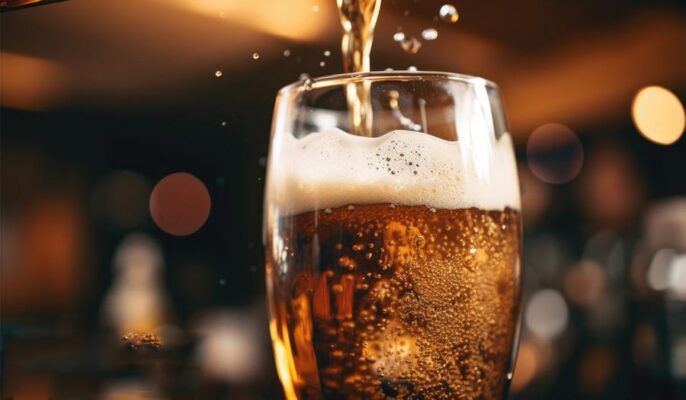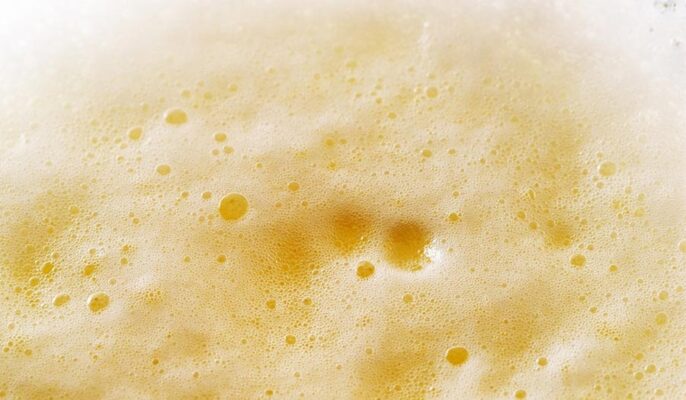Different styles of beer have different levels of carbonation. Carbonation adds mouthfeel and body to a beer and affects the way hop and malt aromas are delivered to the nose. Drinks are carbonated to make them “fizzy.” Carbonation has always been one of the most iconic features that distinguish beer from other alcohols. There is a unique non-carbonated beer, but the audience for non-carbonated beer is small and uncommon. Also, beer will be more or less carbonated during the fermentation process.
What is beer carbonation?
Beer is carbonated by adding carbon dioxide to the beer so that the carbon dioxide dissolves in the beer. To keep carbon dioxide gas in a liquid, pressure is needed. For beer, this pressure might be a sealed bottle cap or label. When the pressure is released, the carbon dioxide rises and escapes in the form of bubbles.
The degree of carbonation in a beer depends on the style of beer. Most beer contains about 1.8 grams per liter (or 2.7 grams per pint) of carbon dioxide. There are usually more lagers and wheat beers than ales, while cask beers usually have less.

Common methods of carbonation
Carbon dioxide is forced into the beer under pressure. There are many ways to achieve this, and it depends on the brewery. Yet, carbonation is generally performed after the beer fermentation is cooled (around 0°C) as the last step before beer packaging and storage.
Additionally, the cooler a liquid is, the more gas it contains. This is called Henry’s Law. Winemakers need to understand and apply this law, which states that higher pressure and lower temperatures help absorb gases through the liquid more .
There are two main ways to carbonate beer: natural carbonation and artificial carbonation.
Natural carbonation
carbonated fossil beers are the most used method of carbonation. Natural carbonation of beer and other alcoholic beverages occurs during fermentation. During fermentation, ingredients such as barley are consumed by yeast and carbon dioxide is produced. While most of the carbon dioxide is lost in later production processes, some usually remains in the beer.
Another method of natural carbonation is to leave some of the yeast and air in the beer when it is bottled, allowing the yeast to continue the fermentation process in the beer. This method is less common, but, as it may not be as effective as carbonation during fermentation.
Artificial carbonation
Artificial carbonation is the process of carbonating beer with the help of various devices. The most common strategy for artificial carbonation is through what’s called “forced carbonation,” which involves cooling the beer and placing the beer in a sealed container to complete the carbonation process.
When the cooling operation is complete, the carbon dioxide is forced into the container and kept for several days. Changes in pressure and temperature allow carbon dioxide gas to be absorbed into the beer and complete the desired degree of carbonation. , the carbon dioxide is absorbed, usually within a few days or a week, and gives the beer its signature bubbles. The most common carbonation barrel strategy used by almost every winemaker is forced carbonation. Because it is one of the most cost-effective and simple methods of carbonation.
Ccarbonation degree
Not all beers have the same carbonation content. At one extreme, we serve real British ales with no added carbonation. At the other extreme, we have beers like the German Weissensee, which are very carbonated and thus are often poured into the glass in stages to allow time to settle before more beer is added.
Carbonation levels are expressed as volumes of carbon dioxide. A volume of CO2 (unitless) is a given volume of gas dissolved into the same volume of liquid. So 1 volume is one liter of carbon dioxide dissolved in one liter of beer, or one gallon of carbon dioxide dissolved in one gallon of beer. Most beers have a carbonation level of 2-3 volumes, but there are some exceptions that fall outside of these ranges. We often adjust the carbonation levels in our beers to match the style of beer we are brewing.

Steps to force carbonation of beer
- Siphon the beer into a sterilized keg and close the lid.
- Connect the gas line and increase pressure to approximately 40 psi. You need to double check for leaks!
- Carbon dioxide dissolves into the beer more when it is cold, so place a keg with a gas line on top of the refrigerator and leave it under pressure for about 24 hours.
- Turn down pressure to 20 PSI for 24 hours.
- Test the carbonation level: Turn the regulator pressure down to about 10 psi and relieve the excess pressure in the keg by raising the pressure relief valve.
- Attach sanitized beer line components, pour beer and enjoy. If more carbonation is needed, turn the regulator to about 20 psi and let sit for another 24 hours.
How to keep beer carbonated?
Note that the carbonation level will decrease over time and you may lose the “bubbles.” This is because unless stored under pressure, the gas will escape into the surrounding environment. Beer and cola are very like carbonated drinks. The carbon dioxide in the cola that is not stored under pressure escapes into the surrounding environment and loses its “bubbles.”
The only way to keep beer carbonated is to store it under the same conditions in which the carbonation occurs. In other words, if you want to store carbon dioxide in beer, you have to store the beer under pressure and at low temperatures.
Once the beer is opened, it should be consumed within a few hours. If you leave it longer, the beer will taste very different from what you imagined, the carbonation will disappear, and it will become unpleasant to drink.
Asked questions about carbonation
Can I bottle age long-aged beer?
If you’re concerned, you can add some extra yeast when bottling the beer from the fermenter to the bottling barrel, make sure it’s homogenized before packaging. I’ve heard of people having success with half a package of dry yeast to a full package of liquid, but I’ve never done that, so do your research if you choose.
Will cold pressing leave enough yeast to carbonate my beer ?
Yes. Chilled crushed beer will still produce carbonation. If you have the means and prefer to pack a clearer beer, don’t worry, there’s still plenty of yeast in the suspension to consume the starting sugars and produce carbon dioxide. If your beer isn’t carbonated, it could be due to a poor seal or the temperature being a little cold. Some people feel that beer also takes longer to carbonate.




